
Major League Baseball and the Players’ Association should be commended for creating the best steroid testing policy and penalty system in all of professional sports. With the Collective Bargaining Agreement expiring after this season, it’s time to reevaluate the steroid policy and make some changes.
After seeing the saga of Jenrry Mejia, I believe there is some room for improvement.
The first issue is that Mejia came back at all in 2015. While Mejia was serving his first suspension, he again tested positive. Mejia got to pitch in seven games before the second suspension was finally levied. At this time, the Mets and Nationals were separated by two games and were about to head into the All Star break. Mejia had an impact on a pennant race even though he tested positive for steroids. Overall, there was no reason why he should’ve played.
Baseball should implement a rule that a player cannot return from a steroid suspension unless they pass a steroid test.
Now, in the case of Mejia, he never would’ve pitched in 2015. That would’ve been a good thing. It would’ve prevented a steroid user from having any impact upon a pennant race.
Keep in mind, this is a slight tweak of the current testing policy. Under the current policy, a player who tests positive is subjected to increased testing over the course of the year. However, it calls for increased random testing, not time specific testing. Rather than do completely random testing, there should be a blood and urine test right before the players is scheduled to return. When and only when the player passes that test, the player can then return.
The next issue to be addressed is what to do with these players if they test positive on their reinstatement test. Under the current policy, these players would receive an additional suspension. As we saw with Mejia, he pitched all of seven games in the 2015 season before his career was done.
Research seems to indicate that anabolic steroids, like the ones taken by Mejia, are addictive in nature. An abuser of anabolic steroids can experience depression, and worse, may become suicidal. Now, I can’t tell you Mejia is depressed or suicidal. What we can see however is that Mejia showed signs of addictive behavior. Mejia continued to use steroids even though it was to his detriment.
Now, if Mejia had been caught using cocaine or another “drug of abuse,” Mejia would’ve been placed in a treatment program. However, because Mejia used steroids instead of heroin, the treatment program was not an option, at least as the drug policy is currently written. It’s very well possible Mejia needed help, and it was not available to him.
Don’t misunderstand me. Mejia is a cheater. He deserved his first suspension. No one ever forced him to take Stanozol. However, if he truly became addicted to steroids, there should be measures in place the help Mejia rather than just throw him out of baseball. Therefore, the penalties for steroid use should be changed to address this issue.
For the first offense, a player should still be suspended for 80 games. However, I believe that should become a minimum suspension. If a player cannot pass the aforementioned reinstatement steroid test, the treatment program provisions of the “drugs of abuse” should come into effect. The 80 game suspension should then become an indefinite suspension. It should not trigger the 162 game penalty at that time.
Under this new plan, a player who tests positive the first time could effectively be suspended longer than 80 games, 162 games, or possibly more. It really is up to the player. If a player is addicted, and needs help, the avenues should be there for them. If the player continues to test positive, and refuses to accept treatment, the “drug of abuse” treatment providions should apply:
- First failure to comply: 15-25 game suspension;
- Second failure to comply: 25-50 game suspension;
- Third failure to comply: 50-75 game suspension; and
- Fourth failure to comply: one year suspension and whatever additional penalties the Commissioner sees fit.
Essentially, the goal should be to get the addicted players the help they need. If they fail to comply, the refusal to seek treatment penalties should apply instead of the 162 game penalty. Once the player has completed their program and can pass a reinstatement test, they should then be allowed to return to baseball.
If, after all of that, a player tests positive a second time, that player should receive the 162 game suspension. After a second suspension, the player should automatically be enrolled in a treatment program. After the 162 game suspension, the player should again be subjected to a reinstatement test. Additionally, that player should not be reinstated until they pass that test.
If a player fails a third test after all of this, that player should then receive the lifetime suspension.
Right now, there is a 26 year old reliever who may have a substance abuse issue. It was his fault for starting in the first place. With that said, baseball failed to put steps in place that could have helped him. The second and third suspensions might have been prevented. If he used cocaine like Josh Hamilton, he would still be in baseball.
Mejia cheated and deserved his suspension. After that, he was penalized because he was addicted to steroids instead of cocaine. It’s time baseball got steroid users the help they may need.
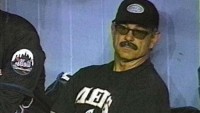
It’s that time of the year when we get that warm and fuzzy feeling. It’s a time when you feel even closer to what you love. I am of course referring to Pitchers and Catchers reporting to Spring Training this week.
As the Mets report, they are trying to do something that only Bobby Valentine’s Mets have ever done. They are trying to go to the postseason for consecutive years. It’s still amazing to think that in the 54 year history of the Mets, they have only e been in consecutive postseasons only once. Gil Hodges couldn’t do it. Davey Johnson couldn’t. Willie Randolph came agonizingly close.
No, the only one to do it was Bobby V. He did it with a core of Mike Piazza, Edgardo Alfonzo, Robin Ventura, and Al Leiter. He had a terrific bullpen of Armando Benitez, John Franco, Turk Wendell, and Dennis Cook. Each year, he had drastically different outfields and rotations. Yet, he was still able to make it work. He got the most out of these teams. The Mets made consecutive NLCS appearances, and they were close to winning a World Series.
This now is the task set forth for Terry Collins. For the first time in 16 years and the second time in Mets history, he is tasked with leading a Mets team to consecutive postseason berths. Like Bobby V, he has a strong core of players. Unlike Bobby V, he has not had much turnover in the roster.
Overall, the one thing uniting Bobby V’s Mets and Terry Collins’ Mets is hope. Mets fans hope and believe in this team. We all believe this is our year even after a heartbreaking loss. And yes, as this is Valentine’s Day, Mets fans love their team.
So remember on this the coldest of Bobby Valentine’s Day, Spring is in the air, and we will soon be reunited with the team we love.

Tomorrow is Valentine’s Day. If you haven’t gotten your wife, fiancée, or girlfriend something, you have less than 24 hours to get something. Good luck on such short time constraints.
Now, if you didn’t send the woman in your life something yesterday, you still have time to do something special. At least from my experience, my wife loves getting flowers at work. It’s a bigger deal around Valentine’s Day because there is usually a parade of flowers coming into the office. You don’t want your significant other to be the person that received nothing:
Luckily, with Valentine’s Day being on a Sunday, you have an out. You can have flowers sent on Monday and pretend it was the plan all along.
Now, I know the main issue with sending flowers this time of year. It’s incredibly expensive. It’s more expensive having them delivered. The price will go up when you consider you’re ordering them at the last minute. There’s a way to dramatically reduce the cost.
Go pick up the flowers yourself. You can get them from a florist or a grocery store. By picking them out yourself, you have the added benefit of making sure the flowers are in good shape. Trust me, these places will send out whatever they have in stock. The only thing worse than sending nothing is sending out garbage. Sending nothing means you forgot. Sending awful flowers embarrasses her. This prevents that.
Once you have the flowers,drive to your significant other’s job and drop it off at the front desk or security. They will deliver the flowers to your significant other’s desk. Trust me. It will have the same effect as the flowers being delivered by a florist or 1-800 Flowers. Remember, the idea is not to spend a lot of money. The idea is to make her happy.
I hope this helps. Good luck and enjoy your Valentine’s Day.
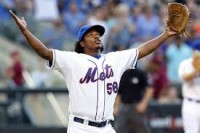
Well unless you’re living under a rock, by now you’ve heard that Jenrry Mejia is permanently suspended from baseball for testing positive for steroids use a third time. The universal take is that he was incredibly stupid. At first, that was my take as well.
However, there is something in me that began to question this premise. The one question I kept coming back to was why would he continue to use steroids while he was on suspension? There was nothing he could gain from it. He wasn’t eligible to pitch until the 101st game of the 2016 season. It just doesn’t make sense for him to get busted for using steroids half a year before he was even allowed to pitch.
To gather an understanding of what happened, let’s first start with the banned substances Mejia was taking and the correlating suspensions:
- April 2015: Stanozol
- July 2015: Stanozol and Boldenone
- February 2016: Boldenone
Looking over this list, there are two things that jump right out at me. The first is he tested positive for a banned substance during a suspension. The next is that each time he tested positive, he tested positive for a banned substance he had tested positive for in an earlier test.
What is interesting about Stanozol is that with one injection, the presence of Stanozol in your system can be identified for several months. Therefore, it is at least possible that Mejia tested positive for Stanozol in April and July for just one injection. What’s problematic for Mejia is he also tested positive for Boldenone in July. As such, there were two banned substances present in his system.
Now, Boldenone can be detected in your system for a whopping 16 – 18 months after its been injected into your body. Again, it is possible that Mejia tested positive twice for one dose. Whether or not you choose to believe this is what happened is up to you. However, scientifically, it is plausible Mejia is getting suspended a second time for the first (and only?) Boldenone dose he took.
For his part, Mejia has stated, “It is not what they say. I am sure that I did not use anything.” He also states that, “I am going to appeal. Lose or win, I have great faith. I have to clear my name. I will take this case to the ultimate consequences.”
It should be noted that Mejia never appealed his first suspension despite claiming he had no idea how Stanzonol got in his system. There were no appeals or statements after the second suspension. It seems now with his baseball life on the line, he’s not going to go down without a fight.
Unfortunately for Mejia, he is unable to appeal this third suspension. If he is going to have if overturned, he will have to go the Tom Brady route and sue Major League Baseball. The question is whether or not he has a good case.
In judging that, we are at a disadvantage. It’s possible that Stanozol and Boldenone could remain detectable in a person’s system over a long period of time. What we don’t know is the levels detected in Mejia’s body. If these levels significantly decreased, it’s possible Mejia got nailed twice for the same dose. That’s inherently unfair. In that respect, remember Mejia twice tested positive for Stanozol in a three month span. However, Stanozol was not found in this latest test.
Stanozol itself is interesting here. This year there was an inordinate amount of Stanozol usage. As a result, Commissioner Rob Manfred determined that the issue needed to be investigated.
Looking over the Stanozol suspensions each player was from Latin America. Over the course of baseball’s steroid testing, players from Latin America have been suspended more than players from anywhere else. The Dominican Republic, where Mejia is from, has more steroid suspensions than any other country. It’s clearly an issue.
For what it’s worth, Latino Sports published an article examining Mejia’s second steroid suspension. In the article, it was alleged Mejia tested positive the first time because of an injection he received while he was having asthma problems. It was also alleged Mejia could’ve avoided the second suspension altogether by naming the individual who gave him the steroids. The article alleges this person was working with other baseball players as well. For his part, Mejia was quoted as saying he had no dealings with that person.
While I’m skeptical about this Latino Sports article, I will admit it fits the narrative of MLB conducting an investigation into the increase in Stanozol usage.
At this point, I don’t know what to believe anymore. On the one hand, I cannot fathom how anyone can continue to take a banned substance knowing if he did his career was over. It’s inane to take something again without first seeing if you could compete without it.
And yet, Mejia did test positive three times. All we have to try to make sense of everything is guesswork and rumors. It’s not exactly how you build a strong case.
While I can rack my brain to try to figure out how this possibly happened, I keep coming back to my initial reaction. Maybe Mejia is just that stupid.
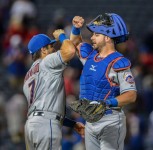
While the Mets have issues regarding their ability to extend their starting pitching, they have other areas to address as well. As it stands, the Mets may have around $97 million off the books by 2019. The Mets will need that money not just to re-sign pitching, but also to build their roster.
One key decision the Mets will have to make is at catcher. By 2019, Travis d’Arnaud will be a year away from free agency. Kevin Plawecki will be in either his first or second arbitration year around the same time.
As it stands going into the 2016 season, the team is best suited to have d’Arnaud starting with Plawecki as his backup. However, I do question if that arrangement is the best situation for the long term. It can be argued with the Mets going into this season with that arrangement, they risk the diminution of the trade value of either or both of these players. It’s a tough decision to make.
Travis d’Arnaud
d’Arnaud is a 27 year old catcher, who is presumably entering the prime of his career. He will be 31 when he becomes a free agent, assuming the Mets don’t work out an extension with him before that.
After working out his game in AAA in 2014, he seems to have fulfilled his offensive potential. When he returned, he hit .272/.319/.486 with 10 homers and 32 RBI in 69 games. He had a low BABIP of .287, which showed these numbers could get even better. They did in 2015. He hit .268/.340/.485 with 12 homeruns and 41 RBI in 67 games last year. He again had a low BABIP of .289. So there may still be room for improvement (assuming of course that the .287 – .289 BABIP is his natural level).
On top of these good and improving numbers, d’Arnaud has shown himself to be a good catcher. He was a highly rated pitch framer in 2014, and he was again in 2015. It’s important to get those extra strike calls to help reduce the pitches thrown by your pitching staff. In fact, d’Arnaud was the best at it last year. Despite his troubles in the World Series, d’Arnaud had an acceptable 32.6% rate of throwing out would be basestealers.
I understand there is more to catching than this, however the other things involved like blocking pitches in the dirt aren’t as quantifiable. Regardless, the most important thing for a catcher is to be a good receiver, and d’Arnaud has seemingly and statistically fine very well in that area.
Between d’Arnaud’s offensive and defensive abilities, you’d be hard pressed to find a reason not to extend d’Arnaud.
Unfortunately, there is a reason. Whether it’s fair or not, d’Arnaud is getting a reputation as injury prone. Last year, d’Arnaud had two freak contact injuries. In April, he broke his pinkie when he was hit by a pitch. When he returned from the DL, he suffered a hyper-extended elbow on a tag play. If that was it, I presume most teams would chalk it up to the freak nature of those injuries. However, he also had a number of injuries in the minors.
This year will be a big year for d’Arnaud. If he stays healthy, he’s primed for a big year; the type of year that will get him paid well in arbitration and free agency. If he gets injured again, he gives validity to the injury prone label thereby diminishing his arbitration and trade value.
Kevin Plawecki
Coming into the 2015 season, Plawecki was a well regarded prospect. Reflecting upon Plawecki’s 2015 season, it’s strange to think he was a highly regarded prospect more because of his bat than his glove.
Like d’Arnaud, Plawecki was exceptional in pitch framing last year. In fact, among big league catchers last year, he was second best. He was not as adept as d’Arnaud in throwing out baserunners. He only threw out 25.6% of basestealers. Given his needing to work on his footwork behind the plate, this should not come as a surprise. Unfortunately, the Mets losing Bob Geren is a hindrance because Geren was well regarded in his ability to work with catchers. That’s not to say Plawecki can’t improve.
Offensively, Plawecki is a different hitter than d’Arnaud. Whereas d’Arnaud has been seen as a power threat, Plawecki is seen as a gap to gap hitter. His offensive game was thought to be so advanced it was thought he could challenge d’Arnaud for playing time last year. That never happened. In part, that is because Plawecki had a tough rookie year.
In an admittedly weak Mets lineup, Plawecki hit a woeful .219/.280/.296 in 73 games. One could be further pessimistic about Plawecki’s offensive potential by looking to his AAA numbers. In AAA, in a hitter’s league, Plawecki only hit .262/.318/.392 over parts of two seasons. However, that’s not the full picture of Plawecki offensively.
Keep in mind, Plawecki only played 65 games in AAA, which is not a full season. Over the course of his minor league career, Plawecki was a much more palatable .290/.364/.432 hitter. Furthermore, while Plawecki’s major league numbers were lackluster, he had a low .277 BABIP. This suggests he’s due for an improvement at the plate next year. Overall, given how well regarded a prospect he is, it would be fair to presume Plawecki could be much better offensively next year.
We also don’t know what, if any effect, Plawecki’s sinus problems had last year. Plawecki admitted he felt dizzy during parts of last season. With his offseason surgery, and a year in the majors under his belt, Plawecki could be due for a much improved 2016.
The main thing holding him back will be d’Arnaud. As d’Arnaud’s backup, Plawecki will get limited reps at the plate hindering his ability to improve. Furthermore, with reduced playing time, Plawecki’s numbers can swing drastically. He’s as likely to have good numbers as he is to have poor numbers. Whichever way it goes, it’s likely to be a small sample size. With that said, if he has another poor offensive season, whether it’s driven by a low BABIP or not, it will be hard to unring that bell.
Another issue is Plawecki’s status as the backup catcher. While it’s understandable the Mets want Plawecki around to play a little more to help keep d’Arnaud healthy, it should be noted that this still makes Plawecki a backup catcher. While his status as a backup catcher will drive down his arbitration numbers, it will also drive down the return you may get for him in a trade.
Why Are They Both on the Roster
Simply put, d’Arnaud and Plawecki are both on the roster because it gives the Mets the best chance to win in 2016. The hope is that Plawecki can catch more frequently than your average backup to keep d’Arnaud fresh and healthy.
In addition, the Mets are contemplating letting both learn other positions to keep them both fresh and get them both enough at bats. It’s more important for Plawecki because he’s still a young prospect who needs at bats. d’Arnaud could also benefit because getting him out from behind the plate should keep him fresh over the course of the year.
As such, the Mets will need both in the majors. If they play it right, they could get good years from both while maintaining or improving their trade value. This could be Terry Collins biggest challenge in 2016.
d’Arnaud’s Potential Contract
Given the expense that will be incurred in locking up the Mets starting pitching, who the Mets keep may be driven by how expensive they will be.
Naturally, d’Arnaud’s value will vary depending upon his health. If d’Arnaud is healthy, the comp I would use for his contract is Russell Martin. When Martin signed his most recent free agent deal with the Blue Jays, he was coming off a career year where he hit .290/.402/.430. With that’s said, Martin was a career .259/.364/.399 hitter, and he was coming off his age 31 season. That is how old d’Arnaud will be when he becomes a free agent.
Now, d’Arnaud has hit for more power than Martin. However, Martin is more durable, and he has been seen as a leader. Martin has averaged 129 games behind the plate. d’Arnaud has not caught more than 108 in a season. However, assuming d’Anaud is healthy, you would envision him being a catcher who is comparable to Russell Martin, if not better. Accepting that premise, here is the breakdown of Martin’s contract:
- 2015: $7 million
- 2016: $15 million
- 2017: $20 million
- 2018: $20 million
- 2019: $20 million
Now, I’m not suggesting the Mets would or should give d’Arnaud a five year $82 million contract. Martin was a free agent, who could’ve signed with anyone. d’Arnaud loses some bargaining power by being arbitration eligible. If the Mets sought to enter into a deal with him, buying out some free agent years, his contract could reasonably look like this:
- 2018: $8 million – $10 million
- 2019: $10 million – $15 million
- 2020: $15 million – $20 million
- 2021: $15 million – $20 million
Assuming this is a fair and reasonable range, the Mets available money, assuming no increase in the payroll, would be between $82 million to $87 million to complete the roster.
Plawecki’s Cost
While d’Arnaud may cost the Mets between $10 – $20 million, Plawecki should cost less. If Plawecki remains with the club for all of 2016, he will likely become a Super Two player (assuming no changes to the CBA). As such, Plawecki would become arbitration eligible in 2019.
Now, if the Mets were smart about tinkering Plawecki’s service time, they could delay his arbitration eligibility until 2020. That would mean in 2019, the Mets would only need to pay him approximately $500-$600 thousand leaving the bulk of the $97 million to pay their starters and fill out the roster.
With that said, if you’re going to keep Plawecki, and make him the starter, you’re going to have to pay him eventually. Judging by typical arbitration figures, Plawecki could earn anywhere from $1 million to $5 million depending on playing time and production. If Plawecki becomes the starting catcher, and he’s productive, he would be at the higher end of the spectrum.
Depending on the decision the Mets make on Plawecki, that $97 million figure could be reduced to the range of $92 – $96 million.
The Decision
Selecting between d’Arnaud and Plawecki is no easy task. While d’Arnaud is more polished offensively and defensively, he is also three years older, and he has a long injury history. He is going to be a lot more expensive than Plawecki at the time the Mets starting pitchers will become free agents.
On the other hand, Plawecki is a well regarded prospect that has yet to produce in AAA or the majors. There is still time for him to fulfill his potential. However, that will be difficult with the Mets keeping him on as a backup limiting his at bats. The best course would be for the Mets to put him in AAA, manipulate his service time, and let him improve. It appears the Mets won’t do that.
No matter what the Mets do, the time to make the decision between d’Arnaud and Plawecki is fast approaching. Sooner or later, the Mets will have to choose between the two. In terms of preserving trade value that decision could be in 2016 or 2017, at the latest. In terms of cost, it appears 2019 is the last date. It would behoove the Mets to make the decision sooner rather than later to maximize the return they would get for either player.
Overall, while he may be much more expensive, and therefore a possible hindrance to re-signing a starter, I would keep d’Arnaud. He’s already shown himself to be an offensive force while being a good receiver. He’s a better bet to produce going forward than Plawecki.
Hopefully, he’s healthy enough to justify an extension, and Plawecki improves enough to become a big trade chip. Ultimately, that is the best case scenario for the Mets going forward.

The NBA All Star Game is coming this Sunday, and it will feature something no one has ever seen before in the Big Four Sports. The All Star Game jerseys will have advertisements. It’s the first step in what may eventually be a permanent feature on NBA uniforms.
Now, this is a common occurrence in other professional sports. Manchester United wears Chevrolet jerseys. The WNBA has advertisements on their jerseys. The MLS has a team named after a sponsor in the NY/NJ Red Bulls. Every NASCAR driver is a walking billboard. Despite all of this, it seems that baseball will sooner eliminate the DH than have advertising on their jerseys (non-Japan games aside).
The seminal moment on this issue arose in 2004. Initially, MLB entered into a deal where the logo for the movie Spider-Man 2 would appear on the bases:

The fans lost their minds. The public outcry was so fervent that two days after the announcement MLB and the movie studio announced the advertisement would not appear on the bases. Over a decade later, it appears that MLB is no closer to advertisements on the field or on the uniforms. For what it’s worth, Commissioner Rob Manfred stated that he does not see advertisements on jerseys happening.
That’s a good thing because jersey advertisements are a problem waiting to happen.
It was less than a decade ago the naming rights issue to Citi Field was a hot button issue. The Mets and Citigroup came under increased scrutiny over the naming right deal because Citigroup had just received a taxpayer bailout. There were cries for the Mets to return the money and find a new sponsor. The outcry would most likely have been even worse if the Citigroup logo was on the Mets jerseys. For those that took issue with the deal, the jerseys would’ve been a constant reminder of that.
As luck would have it, the Mets couldn’t have a Citi Field patch on their uniforms as it was not permitted by MLB. Instead, the Mets had the “Inaugural Season” patch instead of a “Citi Field” patch.

That season the Mets caught more flak for a poorly designed patch than their deal with Citigroup, so to an extent, MLB’s policy had a positive effect.
So while the NBA goes forward with their plan to advertise on jerseys, MLB will continue to keep the field and uniforms free from advertising. At the end of the day, I prefer MLB’s line of thinking. I’m loathe to think of a scandal involving an advertiser that became the focus of each and every Mets game. It was bad enough in 2009. It won’t be and better in 2016 and beyond with Twitter and the like.
So no, advertisements do not belong on MLB uniforms. I’m glad it’s going to stay that way.
Editor’s Note: this article was first published on metsmerizedonline.com
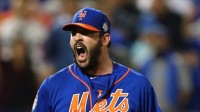
With Carlos Beltran giving his opinion on Terry Collins decision to send Matt Harvey back out for the ninth inning, I began to think of the different ways the Mets won or lost postseason series. Can you name the players involved in the last play in each of the Mets postseason series? Good luck!

Normally, when a player leaves the Mets, I like to take stock of all the good things they did with the Mets. With Eric O’Flaherty it’s near impossible.
When the Mets acquired him, I thought he was the missing piece to the Mets bullpen. He was going to be the LOOGY the Mets needed. Instead, O’Flaherty was just terrible. He had a 13.50 ERA and a 2.654 WHIP. Honestly, I’m not even sure he was that good. To put it in perspective, his ERA+ was 29. TWENTY-NINE! While I could say that there are no words to describe how poorly he pitched with the Mets, I think saying 29 describes it perfectly.
To be fair, there was one good thing that came from the O’Flaherty trade. The corresponding move was the Mets designating Alex Torres and all his hats for assignment. For that, Mets fans do owe him a little bit of gratitude.
Now, he’s off to Pittsburgh on a minor league deal. I’m sure now that he’s completed his post-Tommy John season and his being under the tutelage of Ray Searage, O’Flaherty will return to the effective LOOGY he once was. I’m positive hell revert back to the guy that has a 1.69 career ERA against the Mets.
In any event, O’Flaherty is a Pittsburgh Pirate ending his reign with the New York Mets. I think I speak for everyone when I say that’s best for everyone.
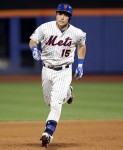
For one reason or another, Travis d’Arnaud switched uniform numbers with bench coach Bob Geren heading into the 2015 season. Now that Bob Geren has left the Mets for the Dodgers, the Mets should not give out the number 15 again.
It’s what the Mets have traditionally done with numbers they have anticipated they will retire. After Tom Seaver was traded to the Reds, no other Met would wear the number 41. After Mike Piazza left the Mets as a free agent, the Mets never re-issued 31. These were two future Hall of Famers that were expected to enter the Hall of Fame as a Met. These are the only players to have their numbers retired by the team. With them, the Mets have created the standard that they will retire the numbers of players that have entered the Hall of Fame as a Met.
With Carlos Beltran announcing he may retire after this year, the Mets should give him similar treatment.
Beltran is coming to the end of a terrific career, one that is certainly worthy of the Hall of Fame. Right now, it appears it’ll be up to Beltran as to whether he enters the Hall as a Met, Royal, or a blank cap. For what it’s worth, Beltran has said that if he receives the honor, it’s possible he could enter the Hall of Fame as a Met. If so, the Mets should effectively retire the number now instead of handing it out to the Fred Lewises and Val Pascuccis of the world. Looking at the Mets current roster, the number hasn’t been assigned. The players without designated numbers aren’t players of Beltran’s caliber.
d’Arnaud should be the last Met to ever wear the number 15. Hopefully, one day the Mets can retire the number 15. Even better, it would be great to retire number 7 for d’Arnaud.
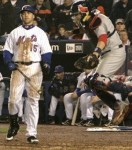
According to WAR, Carlos Beltran is the sixth best Met of all-time. He’s higher ranked than recent Hall of Fame inductee Mike Piazza. He’s a future Hall of Famer. The end of his Mets tenure was the beginning of Terry Collins tenure. When Beltran speaks, he deserves your full attention.
With that said, a person should always pick their spots when to interject an opinion. In his interview with George A. King, III, Beltran offered his opinions on Terry Collins sending Matt Harvey out for the ninth in Game 5 of the World Series. Collins’ decision ranks right up there with Grady Little leaving Pedro Martinez in during Game 7 of the 2003 ALCS. It’ll be talked about for generations. Everyone will have a perspective. For what it’s worth, here was Beltran’s take on Collins sending Harvey back out there:
He was looking down and I felt that he wanted to take Harvey out. But at the same time, Harvey was pitching such a good game and Harvey wanted that moment. He went with what Harvey showed him and not what he was thinking. That’s an experience for him. Later on [taking Harvey out] will happen. He will say,’My friend, I will give you a kiss of I have to, but I have to get my closer.’ It was a bad decision to leave him in, but in his heart I felt that he wanted to make a different move.
It’s a fine and reasonable take, but man, I really don’t want to hear Beltran talking about decision that lead to the end of playoff series. Much like the end of the 2015 World Series, his strikeout at the end of the 2006 NLCS will forever haunt Mets fans. For his part, Beltran said he couldn’t do anything with the pitch. To be fair, it was filthy:
However, with that said, he didn’t try to foul it off. He didn’t try to make a fielder make a play. There would be no little groundball up the first baseline. No, Beltran was beat, and he didn’t go down swinging. This doesn’t change the fact that he was a great Met. It doesn’t mean he shouldn’t be a Hall of Famer. It doesn’t even mean his opinion on Collins sending Harvey back out there was wrong.
No, it just means that when it comes to series altering decisions, Beltran’s opinion is the last one I want to hear.
Editor’s Note: this was first published on metsmerized.com
